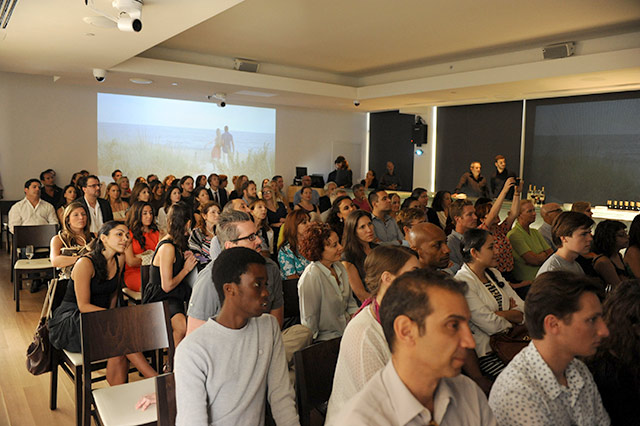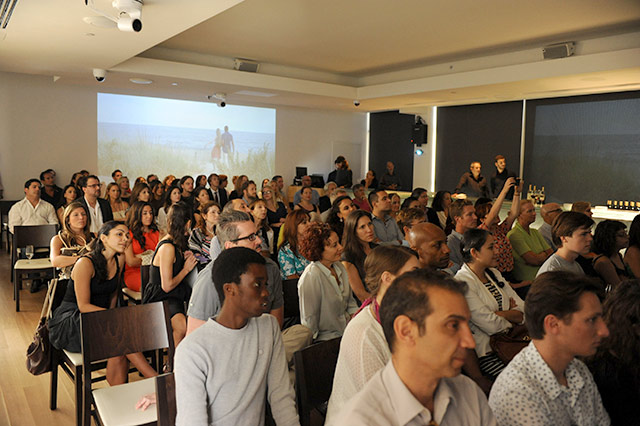
Unlikely artistic duo composes a successful partnership
Photo: Justin Peck and Sufjan Stevens with Knight Foundation President Alberto Ibargüen at the National YoungArts Salon. Credit: World Red Eye.
For any artist, working with a colleague can open new doors of creativity, as successful collaboration entails compromise. It is an art in itself, after all, to make it happen.
And precisely on “The Art of Collaboration” is what the latest installment in the National YoungArts Foundation’s Salon Series was all about, with a discussion that took place on Thursday evening at the organization’s main campus in downtown Miami.
The talk with rising star choreographer and New York City Ballet soloist Justin Peck, and songwriter, singer and musician Sufjan Stevens, was moderated by Alberto Ibargüen, president of Knight Foundation. The foundation provided support to launch the YoungArts Salon Series.
The latest fruit of Peck’s and Stevens’ joint efforts debuted this May with “Everywhere We Go,” a 42-minute work danced by New York City Ballet, with choreography by Peck and music by Stevens (his first original orchestral score). Next spring, Peck will have the world premiere of an as-of-yet-untitled piece for Miami City Ballet, with iconic visual artist Shepard Fairey in charge of the set.
“The way that this came about was because Justin was doing a residency with Miami City Ballet, and I knew of the collaboration between him and Sufjan, so I said, ‘Let’s see if we can bring them in and do this together,’ ” said Paul T. Lehr, president and CEO of National YoungArts Foundation, about the guests for this third salon presentation.
“Obviously, from what YoungArts does, we are really focused on collaboration and interdisciplinary work,” continued Lehr. “We constantly mix these art forms that you otherwise wouldn’t expect to be shown together, and this often leads to something great. These artists learn different ideas and perspectives from each other. The two of them [Peck and Stevens] are just a perfect, shining example of how those kinds of collaborations can lead to extraordinary results.”
Throughout the chat, their connection appeared effortlessly. Peck, 27, looking preppy in glasses and a short-sleeved striped shirt, and Stevens, 39, wearing a cap and displaying a wicked sense of humor, come from very different worlds: Peck trained in ballet, while Stevens hated ballet, excelling instead in a wide range of music styles, from electronica to indie folk.
Stevens recalled how Peck, who had been following his music for some time, approached him via e-mail with the idea of using his music. Stevens didn’t respond right away.
“It was such an eloquent solicitation,” Stevens said about the email, eliciting laughs from the crowd. “He was just saying ‘I am interested in your work and I’m always looking for living songwriters, musicians, composers.’”
Change of heart
Stevens’ misgivings about ballet changed after he went to see “Agon,” he said, a 1957 work choreographed by George Balanchine with music by Igor Stravinsky.
“I didn’t like ballet until I saw ‘Agon,’” the Detroit native admitted. “It just felt like there was a kind of purity to it. It felt undated… It was extremely evocative and emotional, and athletic and fun and competitive, but without any kind of the obvious characteristics of ballet, you know, the emoting, pantomime, the romance, the fighting. All that’s gone, and yet it’s still like the cosmic story of mankind or whatever.”
Peck found his own story to share with Stevens in 2012’s “Year of the Rabbit,” his second work for New York City Ballet, with inspiration from the Chinese zodiac and a classical orchestration of Stevens’ “Enjoy Your Rabbit” electronica album from 2001.
The New York Times called “Year of the Rabbit” a “triumph not just for Mr. Peck but also for the institution that has nurtured him.” And of Stevens’ contribution, it noted: “Both the music and the arrangement are rhythmically frisky and inventive.”
The duo next gave birth to “Everywhere We Go.”
The sounds of creativity
“I really wanted Sufjan as a collaborator because I felt he had this innate ability to write danceable music, which to me is a different genre or category, than classical music,” said the California-born-and-raised Peck. “I think the first I heard of his was the ‘Illinoise’ album [a play on Illinois and noise] years ago, and I remember being taken by his ability to orchestrate totally different things.”
Peck admired the work, like many others who follow Sufjan, and whose level of success still flies under the mainstream radar.
“I knew about Sufjan already. I’ve been a fan of his, and I was immediately interested in this discussion,” said Lee Pivnik, a 2014 National YoungArts Foundation winner in visual arts from Miami who attended the salon.
What mostly appeals to him about Peck and Stevens is what he sees can eventually result from the dynamic between two artists such as these.
“You can get so much inspiration from working with people who are either thinking on the same track or thinking in a completely opposite way,” added Pivnik. “And then you can take things from whatever people are saying to you, and working with them will change your work.”
In that line of thinking, and aware of Peck’s budding reputation, Lourdes Lopez, artistic director of Miami City Ballet, invited him to create a piece for the company, which was also working for the first time with New World Symphony. The result was a pas de deux, 2013’s “Chutes and Ladders.”
For next year, the collaboration between Peck and Miami City Ballet is much more ambitious.
“[Miami City Ballet] is an amazing company,” Peck said. “There’s something really special about the dancers.” He emphasized their sense of camaraderie, positive nature, athleticism and eagerness to collaborate on new projects, which he considered the most important quality.
Lopez remembered discovering Peck’s work around 2010 and being enthralled later on by “Year of the Rabbit.” So when the opportunity to collaborate with New World Symphony arose, she jumped at the idea of bringing him to Miami.
“I don’t choreograph, and one of the things I love to do is to bring artists together to create works for ballet specifically,” said Lopez. “Whether it’s a theater director, a visual artist, a composer, a choreographer, I like to bring them all together and kind of just see what comes up, so that the art form happens less in a bubble but has exposure to all other kinds of information. That’s why I thought that Sufjan and Justin, or Shepard and Justin, were so exciting. These are young artists of today, creating the works of today.”

Recent Content
-
Artsarticle ·
-
Artsarticle ·
-
Artsarticle ·

